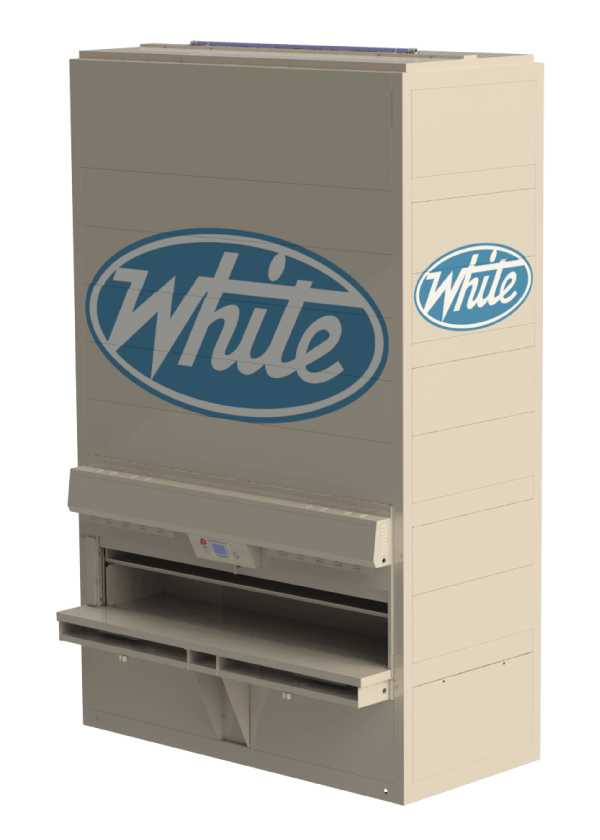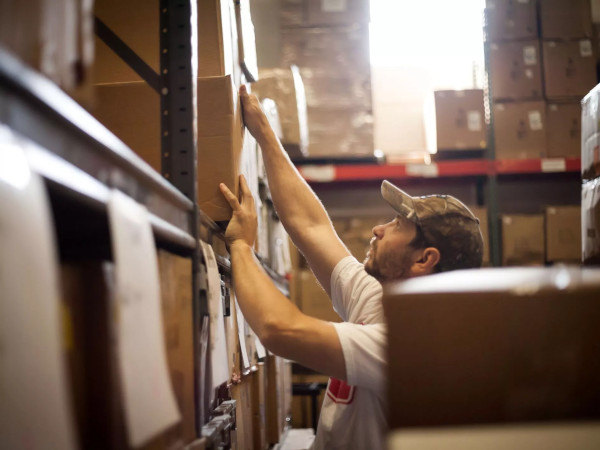What is a vertical carousel?
As the name implies, a vertical carousel is a high-density storage solution that operates on the vertical axis. The mechanism that drives a vertical carousel is similar to the mechanism that drives a Ferris wheel; however, rather than rotating on a circular path, as a Ferris wheel would, the shelving units move up and down vertically, following an elongated oval path.
This configuration means that vertical carousels can more than double the storage capacity of ordinary static shelving units. In addition, vertical carousels can significantly improve warehouse performance. That’s because a vertical carousel’s internal mechanism is integrated with computer software, creating a true “goods-to-person” delivery system. When a certain product needs to be picked, it is the software that directs the carousel to present the correct tote to the operator at the work counter. This accelerates pick speed, improves picking accuracy, and enhances workplace ergonomics.
Automated storage solutions offer many advantages vs. static shelving
Traditionally, most warehouse inventory has been stored on static shelving systems consisting of pullout drawers, wire racks, or pallet racking. Because the dimensions on static systems are fixed, they cannot optimize warehouse space. Other more advanced storage solutions—whether they are vertical or horizontal carousels or vertical lift modules (VLMs)—can store items more densely than static shelving. These automated systems are all “goods-to-person” solutions because they utilize an operator based in a centralized location, and the goods move to the operator, rather than the operator moving to the goods.
Vertical carousels offer a variety of business benefits
Vertical carousels offer numerous business benefits, ranging from increasing available floor space and maximizing storage density to accelerating pick speed, improving picking accuracy, and enhancing workplace ergonomics.
Vertical carousels can increase available floor space and maximize storage density
Vertical carousels are taller than they are wide. That means vertical carousels have a small footprint on the warehouse floor, freeing up valuable horizontal square footage for purposes other than storage. Put another way, vertical carousels optimize overhead air space, which is also known as “air rights.”
Air rights tend to be the most underutilized space in factories and warehouses. Think about a typical warehouse, where the ceiling is 30-feet high. If that warehouse is using static shelving for storage, the shelving units are likely to be only 10-feet tall. That leaves about 20 feet of unused overhead space. Vertical carousels tap into that potential, increasing storage capacity without increasing the footprint on the warehouse floor.
Vertical carousels accelerate pick speed
In warehouses that use vertical carousels, operators do not need to walk aisle by aisle to pick product. Instead, inventory is stored in the vertical carousel, and integrated computer software is used to call up product for delivery directly to the vertical carousel’s counter. This creates a true goods-to-person automated storage and delivery system.
Vertical carousels also have a pick-to-light feature that lights up on the counter, identifying the product that’s supposed to be picked, the quantity needed, and the part, serial, or stock number.
Vertical carousels improve picking accuracy and inventory control
Pick-to-light feature directs the operator to the tote they’re supposed to pick. It also identifies the correct bin within the tote and the required product amounts. This is all accomplished by technology that utilizes the data stored in the vertical carousel’s computer. Picking accuracy is critical, especially in hospital pharmacies.
The operator can then pick the product and scan its bar code, verifying that they are picking the right product and the right quantity at the right time. This process significantly accelerates picking speeds.
In fact, one pharmacy vertical carousel user reduced pick rates by 50% after installing our vertical carousel. (Note: The pick-to-light feature is also known as a put-to-light or pick bar.)
Vertical carousels offer ergonomic benefits
Vertical carousels eliminate the need for operators to bend or reach for items when picking. That’s because vertical carousels present product to operators at a counter that is 40 inches from the ground, the height recommended by agencies around the world as optimal for a work source. In addition, when vertical carousels are used, operators do not have to walk the warehouse floor or use a ladder or man lift machinery to access items stored on elevated shelves. Ergonomic benefits like these enhance employee satisfaction and lead to improved warehouse productivity.

The mechanism that drives a vertical carousel is similar to the mechanism that drives a Ferris wheel. However, rather than rotating on a circular path, as a Ferris wheel would, the shelving units move up and down vertically, following an elongated oval path.
The rotation is driven by a motor that spins a drive chain, which is attached to a torque tube extending across the interior of the carousel. This creates what is called a “drive side” and an “idle side.” But because the torque tube on the drive shaft is synced with the drive side, when the drive side spins, the idle side spins, generating the vertical motion up and around, over and over.
The internal mechanism of a vertical carousel is integrated with computer software, and when a certain product needs to be picked, it is the software that directs the carousel to the correct tote level. Within the vertical carousel, there is also a control box that receives the signal for a pick or a move. Once that signal is received, the motor spins the drive chain attached to the torque tube, and the vertical carousel turns to present the right shelf at the counter.
At the same time, the pick-to-light feature on the counter identifies the product to be picked, the quantity needed, and the part, serial, or stock number. The operator can then pick the product and scan its bar code, verifying that they are picking the right product and the right quantity at the right time.
